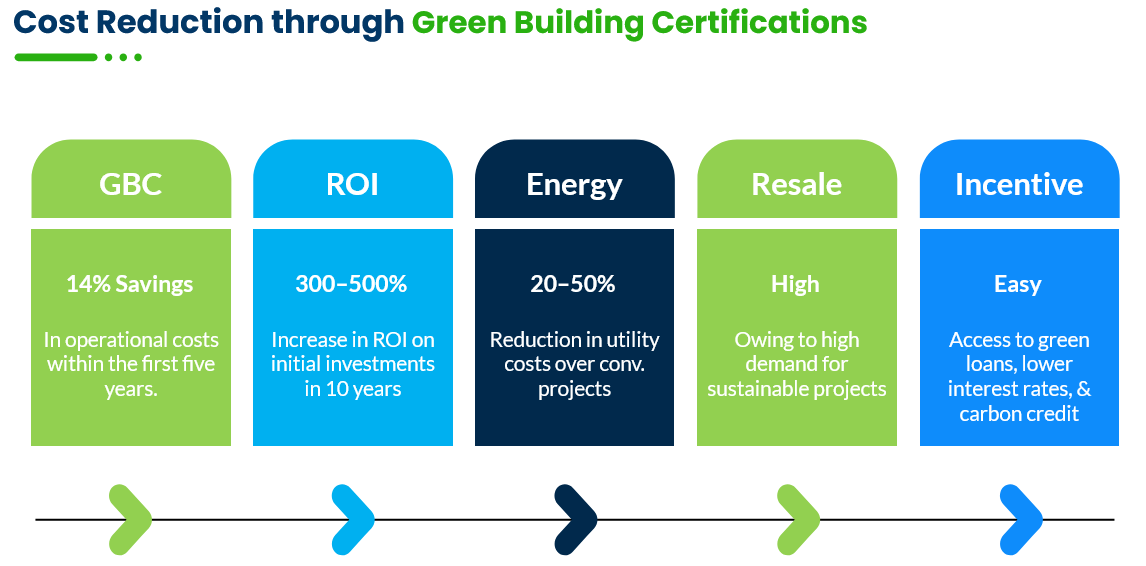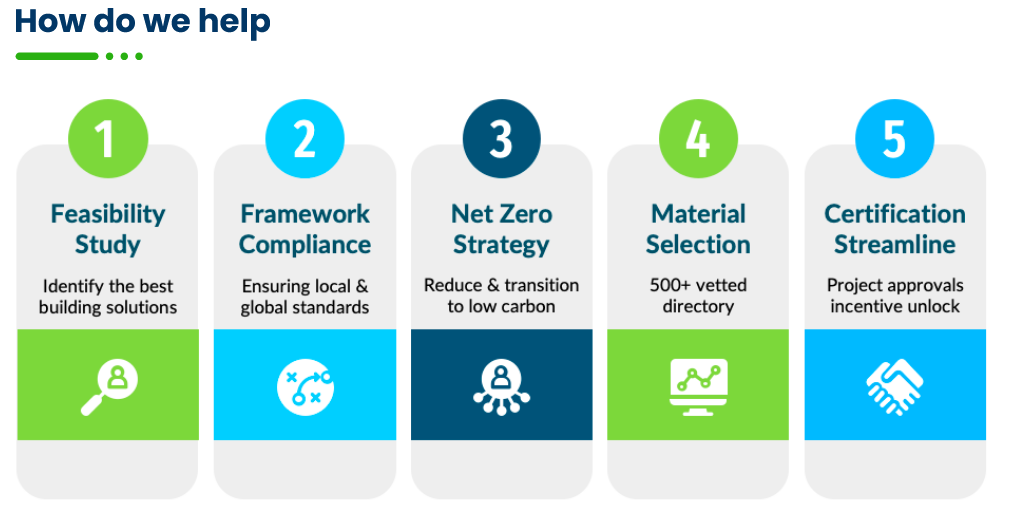Green Building Consultant help projects in evaluating the sustainability and environmental performance. The built environment has a critical role to play in responding to climate crisis. Today, Buildings are responsible for 39% of annual global greenhouse gas emissions and 40% of all raw material consumption. They contributes to reduce carbon emissions, helps combat climate change, and preserve natural resources. Some quantifiable numbers 30–50% reduction in energy consumption, up to 40% reduction in freshwater demand, 40–65% reduction in building water consumption,30–40% reduction in operational cost of buildings. Green Building Certification also gives government incentives like additional FSI and Tax rebates.
Green building certification recognizes and rewards buildings constructed and operated in an environmentally responsible, efficient, and resource-conscious manner. It is a formal process with a set of rating systems and tools which are used to assess a building or any construction projects performance from a sustainability and environmental perspectiveGreen Building Certifications support reducing carbon footprints and drive eco-friendly construction worldwide. Sustain and Save's green buildings consultant helping in designing and operating to minimize environmental impacts and enhance resource efficiency across its entire life cycle.
Why us ?
With over 15+ years of Experience in Green Buildings, with over 200+ Projects pan India in different Residential, Commercial, Hospitals, Homes, Schools and Government, Sustain and Save has the expertise, Knowledge and greent building consultant team to deliver end to end solutions for Green buildings Certification for your organization and projects. Worked with more than 50++ Clients across India in different cities, Our team now aims to achieve excellence by
- Transforming projects into powerful success multipliers
- Enabling products to evolve into circular, future-ready solutions,
- Empowering people to become informed changemakers who recognize the deeper value of every sustainable decision
Benefits of Green Building Certification
Pursuing and earning green building certification offers substantial benefits:
- Resource Management: Reduced emissions of, water and energy, thereby saving carbon, minimized natural resource depletion and Biodiversity Preservation.
- Cost Savings: Lower utility bills thanks to efficient energy and water systems and design.
- Market Advantage: Higher Sales values, increased demand from sustainability-minded tenants.
- Regulatory Compliance: Meeting current and anticipated government standards.
- Corporate Social Responsibility: Visible support for community and environmental well-being.
- Health & Productivity: Enhanced indoor environments promote occupant health, comfort, and work performance.

Green building consultant is essential for both property owners and occupants:
- It demonstrates a real commitment to sustainability goals.
- Increases property value by signalling eco-friendly credentials to buyers and tenants.
- Ensures compliance with fast-evolving environmental regulations.
- Helps promote healthier, safer, and more productive living and working environments.
Green Building certification system assesses a number of sustainability factors:
- Energy Efficiency: Designing buildings for Passive strategies and low energy active systems, Use of alternate energy sources and renewable sources, efficient HVAC systems, lighting systems etc..
- Water Management: Rainwater harvesting, wastewater recycling, and water-saving fixtures.
- Material Selection: Preference for recycled, local, and non-toxic building materials. (better framed. Certification importance.
- Indoor Environment Quality: Natural light, ventilation, low-emission finishes, thermal comfort.
- Waste Management: Construction and operational waste reduction, recycling, composting.
- Life Cycle Impact: Assessment of a building’s environmental footprint from design through operation.

Major Global Green Building Certifications
Major global green building certifications: LEED, WELL, EDGE, IGBC, GRIHA and GEM.
LEED (Leadership in Energy and Environmental Design)
Developed by the US Green Building Council, LEED is the world's most widely used green building rating system, certifying projects based on criteria such as energy efficiency, water usage, indoor environmental quality, and sustainable materials.
Certification levels: Certified, Silver, Gold, and Platinum, determined by points earned in various sustainability categories.
WELL Building Standard
Focuses on occupant health, comfort, and well-being by evaluating features like air, water, nourishment, fitness, and mental health.
Uses performance-based testing and on-site verification.
EDGE (Excellence in Design for Greater Efficiencies)
Developed by IFC (World Bank Group), EDGE is a practical and increasingly popular standard for new construction in emerging markets, requiring at least 20% savings in energy, water, and materials.
Certifies projects globally and is recognized for its simplicity and scalable process.
Green building certification in India is primarily achieved through systems like IGBC, GRIHA, GEM each focusing on promoting sustainable, energy-efficient, and environmentally responsible construction and operation practices. We assist you in completing and fulfilling all the regulatory requirements and documentations to get you a green building certificate.
IGBC (INDIAN GREEN BUILING COUNCIL)
Part of the Confederation of Indian Industry (CII) which was founded in the year 2001.
Wide range of rating systems for all types of projects, from green homes to green hospitals and schools.
Offers multiple rating systems for residential, commercial, and large developments. Ratings include Certified, Silver, Gold, and Platinum levels based on points earned for sustainability measures
India has over 7,000 IGBC-certified green building projects, with another source from the IGBC indicating more than 15,800 Green Buildings projects registered with the council as of August 1, 2023, out of which 6,410 Green Building projects were certified and fully operational.
GRIHA (Green Rating for Integrated Habitat Assessment)
Established in collaboration with TERI and the Government of India’s Ministry of New and Renewable Energy.
Evaluates the environmental performance of a building holistically over its entire life cycle.
Is a three-tiered green building design evaluation system in which structures have been evaluated are: Pre-construction stage, Building planning and construction stage and Building operation and maintenance stage
GRIHA is tailored to India’s climate and construction context. Projects are rated from 1 to 5 stars.
GEM stands for Green and Eco-friendly Movement.
Driven by ASSOCHAM with the objective to promote environment friendly.
Based upon BEE ECBC 2017 and NBC 2016.
Award the Sustainability Certification Rating to Housing, Urban Developments, Residential, Commercial, Hotels, College, Universities, Schools, Factory buildings and related developments.

How Does Green Building Certification Work?
The certification process typically follows structured stages:
1. Project Registration
The owner or developer registers the building with a chosen certification body (e.g., IGBC, LEED, GRIHA).
2. Design & Planning
Green strategies—energy efficiency, water saving, material selection, site management—are integrated into design and construction plans.
3. Documentation Submission
Extensive documentation (plans, impact studies, performance data) is compiled and submitted for review.
4. Review & Assessment
The certification body’s technical panel evaluates submitted documents and may require further clarifications. Some rating systems (e.g., Green Globes, LEED) involve either a remote review or site verification.
5. Site Verification (If Required)
Certain systems mandate on-site inspections to verify implementation of claimed green measures (e.g., Green Globes, Living Building Challenge).
6. Certification Award
If the project meets all criteria, it’s awarded the relevant rating (e.g., LEED Gold, IGBC Platinum, GRIHA five-star).
7. Ongoing Monitoring
Periodic audits may be required to retain green status, especially for certifications focused on operational performance.
Along with Green Building Certifications and Consultancy , we offer the following Services for various buildings :
Building Performance Simulation
Performing comprehensive analysis of building design at the conceptual stage for daylight analysis for visual comfort, artificial lighting analysis for energy savings, material feasibility and thermal comfort impact studies and wind and energy analysis with simulation software for standards like ASHRAE and ECBC that help predict the performance of efficient and comfortable buildings.
Environmental Clearance (EC)
Environmental Clearance (EC) is the mandatory government approval granted to projects that could significantly impact the environment, ensuring sustainable development and Environmental Clearance is a critical regulatory safeguard for balanced, eco-friendly growth and aligns with global best practices in environmental protection.
Allied Reporting for Environmental Clearance
Commissioning
NetZero Assessment and Certification
NetZero Assessment and Certification is a formal process to verify that a building achieves zero net carbon emissions (or net zero energy/water/waste) over a defined period, based on strict operational and documentation standards.
Life Cycle Analysis of Buildings
Life Cycle Analysis (LCA) of Buildings is a structured scientific methodology for quantifying and evaluating a building's environmental impacts throughout its entire existence—from resource extraction to demolition or reuse.LCA can be performed for Buildings, processes and products.
Environmental and Energy Audit
- Holistic assessment of environmental parameters like energy, daylight, acoustics and thermal.
- Identifying areas for efficiency improvement and provide tailored solutions for optimization.
- Conducting 3rd party commissioning and auditing for green building performance.
At Sustain and Save we provide reporting for all allied services required for Environmental Clearance. Sustainability planning yields long term environmental benefits. Analyzing all the ecological parameters and indexes allows us to understand the surroundings and also helps us create better design strategies that will be environmentally sustainable .We do contour analysis and keep the land suitability index in check to understand the built and unbuilt ratio and its impact on projects. We also assist organisations record their carbon footprint and conduct green events for a sustainable environment.
Every project has unique needs and requirements that need to be met to acquire a green building certificate; be it an office, a bungalow, a building or a big organization.
At Sustain and Save, Green Building Consultancy is now offering an comprehensive integration with an AI enabled Platform which helps in the following.
- Seamless integration between digital capabilities and human expertise, ensuring that technology amplifies rather than replaces critical thinking and strategic insight.
- Feasibility study of building project to understand the best possible solution
- Improve the environmental performance of your Project
- Green Building Certification Frameworks like LEED, IGBC, GRIHA, GEM, GRESB compliance covered
- Green building material options, vendor selection, design reinforcements
- All documentation and allied requirements covered
In the Built Environment focussed on the Building and Construction Sector, Sustain and Save delivers energy and smart solutions making sure their projects have
Clarity
Simplifying the Certifications , Audits & Compliance, and design strategies for developers, architects, and public agencies.
Speed
With the Material & Design Optimization (Design Support, LCA, Sustainable Materials) we help in Accelerating planning, procurement, and execution for net-zero and green building projects.
Impact
with our Data & Digital Intelligence (Intelligence Engine, Digital Dashboards, Monitoring ) we Deliver tangible outcomes such as energy savings, carbon reduction, and optimized building performance.
Green building consultant is transforming the way buildings are designed, built, and operated around the world. They signifies not only environmental responsibility but also long-term economic, occupancy, and health benefits. With a variety of Green building certification systems tailored to local and international standards, achieving green certification is an investment in property value—and the planet’s future.
For developers, businesses, and communities keen to align with sustainability, green building certification remains a vital, accessible path to a better tomorrow.
